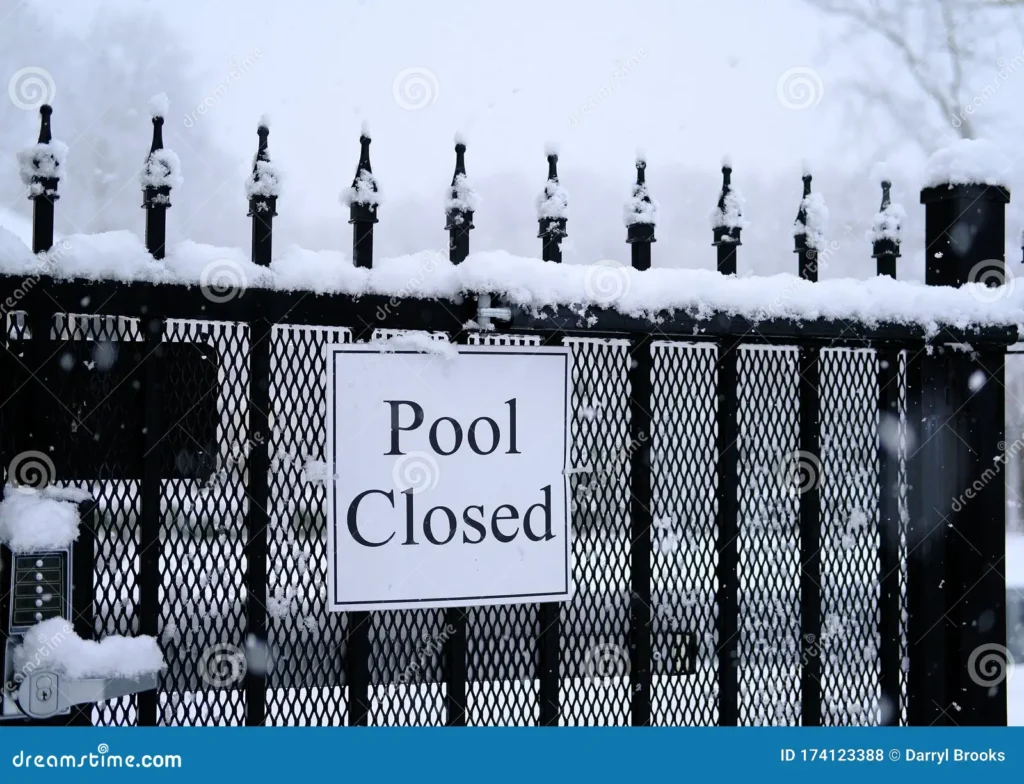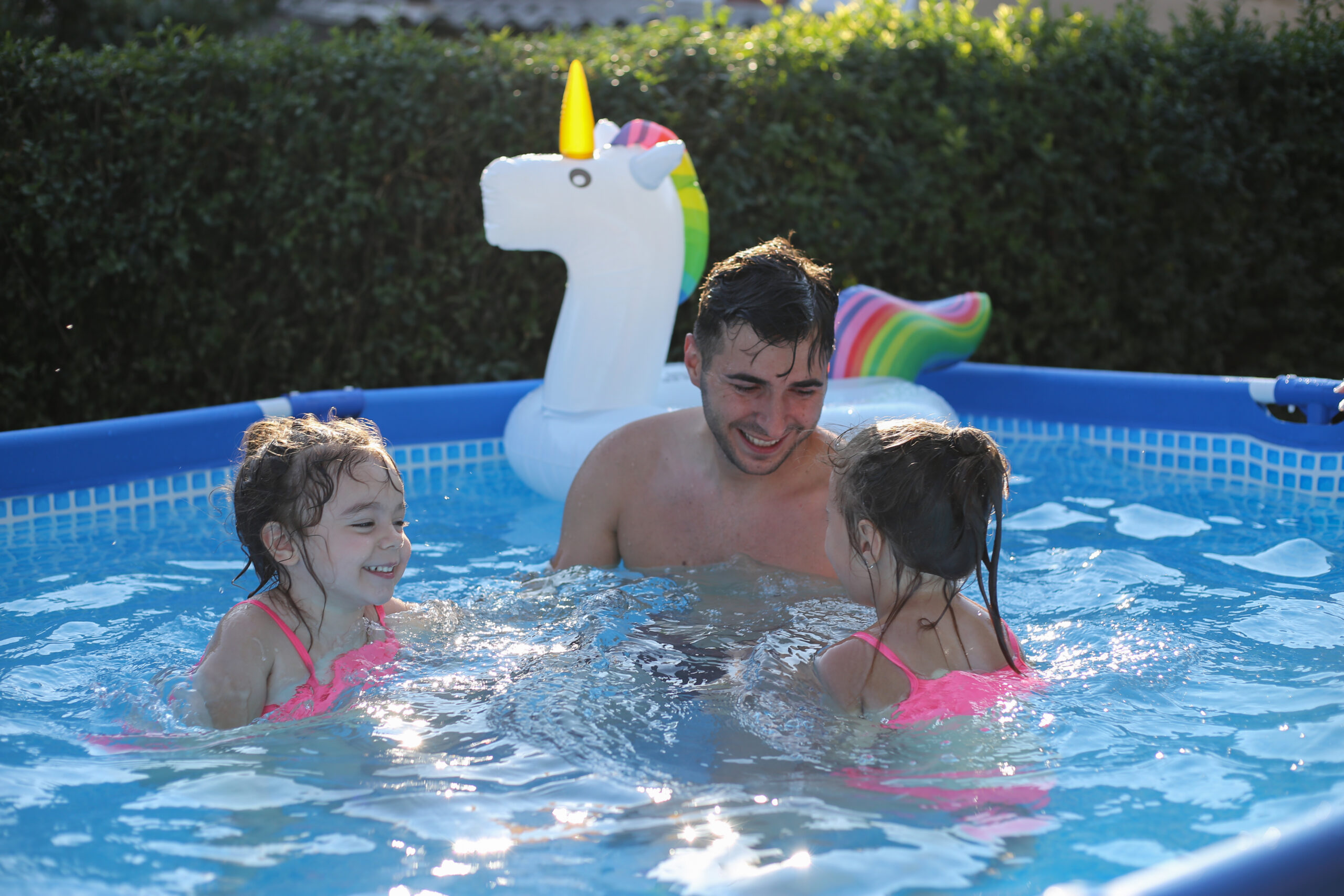Winter pool safety tips are essential for anyone with a closed pool during colder months. It’s crucial to ensure that your pool is secured and safe for the colder months, not only to preserve its condition but also to protect family members, pets, and neighbors. This guide will walk you through essential winter pool safety tips, from setting up barriers to securing your chemicals, so you can enjoy peace of mind all season long.
1. Secure Pool Covers: Your First Line of Defense in Winter Pool Safety
A solid, well-secured pool cover is essential for safety. Winter pool covers help prevent debris from contaminating the water, preserve pool equipment, and, most importantly, keep people and animals from accidentally falling in. For more comprehensive pool safety information, check out the American Red Cross Home Pool Safety Guide, which offers valuable tips on keeping your pool area safe year-round.
- Choose the Right Cover: Opt for a high-quality, heavy-duty pool cover that can support weight. Mesh covers, solid vinyl covers, and automatic pool covers each offer unique benefits, but safety covers are best for protecting against accidental falls.
- Check the Fit: Ensure your cover fits tightly, without any gaps along the edges. A loose cover can create dangerous weak points, which may trap a pet or child if they attempt to walk on it.
- Reinforce Regularly: Snow and ice can put additional weight on pool covers, so it’s essential to periodically clear off heavy accumulations with a broom. Avoid sharp objects, which can tear the cover and compromise safety.
2. Essential Winter Pool Safety Barriers and Fencing Tips
A pool fence is one of the most effective barriers to unauthorized or accidental entry, especially in the winter when pool areas may be less visible under snow or ice.
- Inspect Existing Fencing: Check that the fencing around your pool is in good condition, with no loose or damaged panels. Ensure that gates are secure and equipped with locks to prevent easy access.
- Consider Additional Barriers: Beyond a fence, add seasonal barriers like mesh netting over the pool cover or additional safety fencing closer to the pool’s perimeter.
- Remove Access Points: If there are any objects like lawn chairs, ladders, or tables near the pool fence that children or animals could use to climb, move them far from the pool area.
3. Post Clear, Visible Signage
Even with a cover and fence, posting signs around the pool area can remind guests and family members to stay clear. Winter often limits visibility, so signage helps maintain clear boundaries.
- Use Waterproof, Durable Signs: Make sure the signs can withstand winter weather without fading or peeling.
- Mark Hazards and Warnings Clearly: If there are any specific warnings about the pool’s condition during winter, such as ice hazards or unsecured sections, highlight them in bright colors.
- Add Notices About Pool Maintenance Dates: Display dates when the pool will undergo routine winter maintenance or when it will be uncovered for brief checks. This helps prevent accidental access during those times.
4. Store Pool Chemicals Safely and Securely
Proper storage of pool chemicals is vital during the winter. When mishandled or improperly stored, these substances can pose health risks, cause fires, or even explode under certain conditions.
- Choose a Cool, Dry Location: Store pool chemicals in a space that remains cool and dry through winter. Basements or outdoor sheds with controlled temperatures are ideal.
- Proper Chemical Storage for Winter Pool Safety: Place chemicals on sturdy shelves, away from any potential water sources, which can trigger harmful chemical reactions.
- Label Clearly and Store Separately: Keep chemicals like chlorine, algaecides, and shock treatments in their original containers, with labels clearly visible. Avoid storing incompatible chemicals, like chlorine and acid-based cleaners, near each other to prevent dangerous interactions.
5. Regularly Inspect the Pool Area
While your pool may be “closed” for the season, maintaining regular checks around the pool area ensures any new safety risks are promptly addressed.
- Examine the Cover Weekly: Check for signs of wear and tear on the pool cover, especially around the edges where it may be more vulnerable. Look for pooling water, tears, or loose spots.
- Clear Debris: Snow, ice, and fallen branches can weigh down or damage pool equipment, so keep the area as clear as possible.
- Assess Fencing and Locks: Inspect fences, gates, and any secondary barriers weekly to confirm they are still in place and secure.
6. Keep the Area Well-Lit
Winter’s shorter days mean darkness settles earlier, which can increase the risk of accidental falls near the pool area. Good lighting keeps the pool perimeter visible and reminds people where the pool area begins and ends.
- Install Motion-Sensor Lights: Adding motion-sensitive lights near the pool can illuminate the area whenever someone approaches, reducing the likelihood of accidental entry.
- Check Lighting Fixtures: Regularly inspect outdoor lights to ensure they’re functioning properly and replace any burnt-out bulbs. Use weather-resistant fixtures to prevent winter damage.
- Solar-Powered Lighting as an Eco-Friendly Option: Solar lights can provide consistent illumination around the pool without relying on electricity. Be sure to choose models rated for colder temperatures.
7. Winterize Pool Equipment Carefully
Protecting pool equipment during winter is important to prevent costly repairs and maintain safety. Winterized equipment reduces the need for maintenance checks and avoids issues that could create hazards.
- Drain and Store Pool Accessories: Pool toys, ladders, and skimmers should be thoroughly dried and stored indoors. Wet items left outdoors can freeze to surfaces, creating tripping hazards.
- Secure Pool Filters and Pumps: Once properly drained, cover pool filters and pumps with protective cases to keep out moisture. If possible, store smaller equipment indoors to avoid exposure to extreme temperatures.
- Use Freeze Protection Devices: In colder climates, freeze protection devices can help keep essential equipment like pipes and pumps from freezing, which can lead to costly repairs or leaks.
8. Keep Your Family and Pets Safe with These Winter Pool Safety Tips
Ensuring everyone in your household understands winter pool safety is a key preventive measure. Encourage neighbors and guests to observe the same caution around your pool, especially if it’s visible from their property.
- Discuss the Dangers of Ice: Children and pets may not understand the risks associated with walking on a covered or frozen pool. Explain the potential hazards and make sure they know not to approach the pool area.
- Limit Outdoor Play Near the Pool: Encourage activities in designated areas away from the pool and consider using temporary barriers during winter gatherings to keep everyone safe.
- Supervise Pets: If you have pets, train them to avoid the pool area during the winter. Fencing helps, but a little extra training can prevent accidents.
9. Prepare for Emergencies
Accidents can still happen despite precautions. Having emergency measures in place can make a difference in response time and outcome.
- Keep Emergency Equipment Accessible: Items like reaching poles, life rings, and a well-stocked first aid kit should be easy to access, even in winter.
- Have Emergency Contacts Ready: Post a list of emergency contacts, including poison control, your local animal control, and your vet (if you have pets), near the pool area for quick access.
- Consider Safety Alarms: Pool alarms can alert you if someone or something enters the pool area when they shouldn’t. These alarms are especially useful if you have small children or pets and can provide an extra layer of security in winter.
10. Plan for Safe Maintenance Checks
Winter pool maintenance is essential to keep everything in good working order, but the risks of entering the pool area remain.
- Schedule Professional Inspections: Many pool maintenance companies offer winter check-ups to assess pool cover integrity, equipment condition, and chemical storage. It’s a good option if you’d prefer to stay clear of the pool yourself.
- Wear Slip-Resistant Footwear: If you’re conducting maintenance yourself, ensure you’re wearing sturdy, slip-resistant boots, especially if there’s snow or ice around the pool area.
- Work in Daylight: Schedule maintenance checks during daylight hours to maximize visibility and minimize the risk of slips or falls.
11. Prevent Algae and Water Contamination
While covering your pool significantly reduces the risk of algae and bacteria, it’s essential to manage water chemistry for overall pool health.
- Check Water Chemistry Occasionally: Use test strips to check the water balance periodically, as balanced water chemistry minimizes algae growth and prevents unpleasant surprises in the spring.
- Add a Mid-Winter Shock Treatment (If Needed): A pool shock treatment mid-season can help keep algae at bay. Be sure to follow instructions carefully, as each pool type may require different procedures.
Wrapping Up
Winter pool safety is about creating a multi-layered approach to protect those around your pool while also caring for the pool itself. With secure covers, well-placed barriers, safe chemical storage, and a few additional safety measures, you can keep your pool area safe and enjoy a worry-free winter. Remember these winter pool safety tips to ensure a safe and well-maintained pool area until spring.



